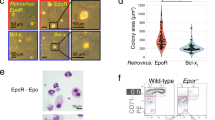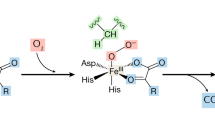Abstract
The production of erythropoietin (Epo), the glycoprotein hormone which controls red blood cell formation, is regulated by feedback mechanisms sensing tissue oxygenation. The mechanism of the putative oxygen sensor has yet to be elucidated. There is evidence that at least two pathways participate in hypoxia signal transduction. One appears to involve a specific haem protein, and a second implicates reactive oxygen species (ROS). Iron catalyses the generation of intracellular ROS and therefore alters the cellular redox state. We have investigated the effect of modulating intracellular iron content on Epo production in Hep 3B cells. Iron chelation stimulates Epo production at 20% O2 and enhances Epo production at 1% O2, but it has no additive effect on cobalt-induced Epo production. Excess molar iron inhibited Epo production in response to hypoxia, desferrioxamine (DFO) and cobalt chloride and inhibited the DFO-enhancing effect of hypoxia-induced Epo production. We found that sulphydryl oxidising agents exert a differential inhibitory effect on hypoxia-induced versus DFO-induced Epo production, providing further evidence that multiple pathways of oxygen sensing exist.
Similar content being viewed by others
Author information
Authors and Affiliations
Additional information
Received: September 21, 1998 / Accepted: March 15, 1999
Rights and permissions
About this article
Cite this article
Daghman, N., Elder, G., Savage, G. et al. Erythropoietin production: evidence for multiple oxygen sensing pathways. Ann Hematol 78, 275–278 (1999). https://doi.org/10.1007/s002770050514
Issue Date:
DOI: https://doi.org/10.1007/s002770050514




